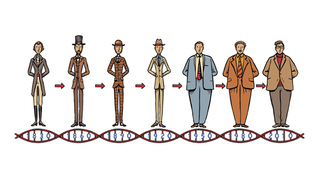 loading
loading
FindingsNature, nurture, and nativityHow your genes behave may depend on your birth year.  Gregory NemecView full imageThe link between obesity and the FTO gene—the so-called “fat gene”—is so well established that it’s literally a textbook example: the gene’s association with weight gain is often cited in medical teaching texts. But when Yale scientist Nicholas A. Christakis ’84 and his colleagues researched the gene’s influence, they discovered a pattern that undermines the scientific consensus—not only about this particular gene, but also about how genes work in general. Christakis, the Sol Goldman Family Professor of Social and Natural Science, and his colleagues wanted to investigate how environmental factors affect genes’ impacts, a notoriously difficult question. They studied medical records compiled on more than 5,000 adults who were part of the famous Framingham Heart Study, begun in 1948, which tracks the overall health of people from a single small Massachusetts town. What they found was that the FTO gene only “worked” in people born after 1942. Its correlation with higher body mass index didn’t show up at all in people born before then. “Something about the environment changed and allowed the gene to be expressed,” says Christakis. The best guess is that the increased availability of higher-calorie foods and a more sedentary lifestyle changed the gene’s effects. (The results appeared online in December in the Proceedings of the National Academy of Sciences.) This result, Christakis says, introduces new uncertainties into gene research. Scientists must now ask whether the effects of any given gene could vary for different age cohorts—and whether the effect a researcher finds today might change years later. Says Christakis, “This is a radical finding that underscores the need for caution and humility.”
|
|
2 comments
-

Steven S. Hall, 2:56am March 29 2015 |  Flag as inappropriate
Flag as inappropriate
-

George Henderson, 7:20pm April 21 2015 |  Flag as inappropriate
Flag as inappropriate
The comment period has expired.1942. Essentially WWII started then. Bottle formula introduced? Margarine introduced? It is a fact that, growing up, physical activity was MUCH more in our daily lives than only a few years later. We thought nothing of massive amounts of walking and even bike riding.
DDT pretty much dates from 1942 and was used prodigally in the post-war period. Vitamin fortification of US grain products also dates from 1942, and might be expected to have influenced gene expression, as well as the physiological ability to store fat (lipogenesis and overeating are suppressed by low thiamine status).